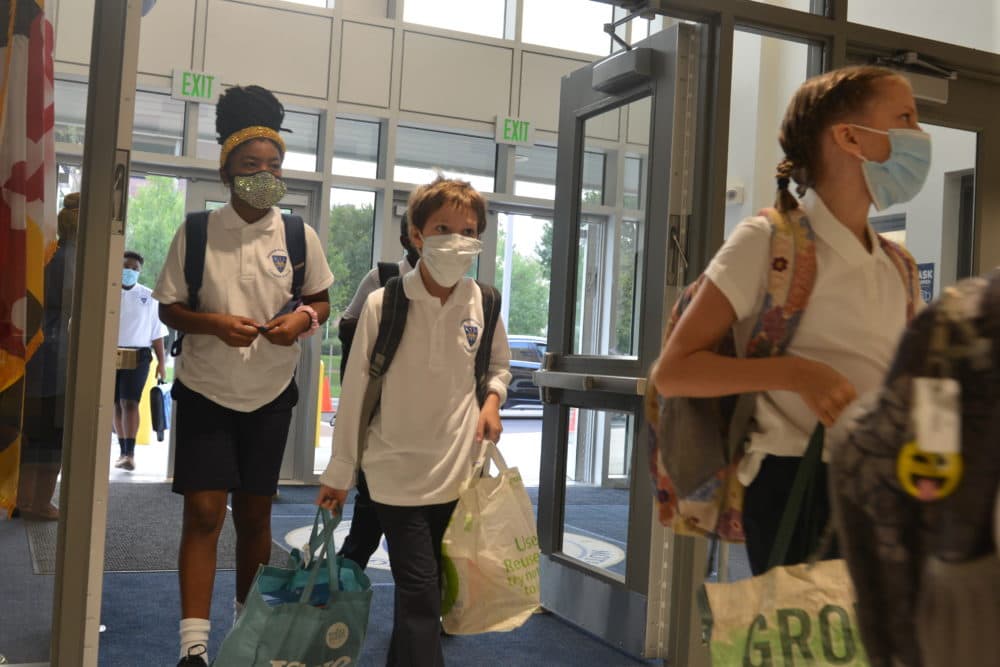Advertisement
Commentary
School's Back! Now Can We Please Keep Some Lessons From Hybrid Learning?

The change happened suddenly, like a bandage ripped off a boo-boo that had already healed. One week, we were deep in our hybrid routine, a luxurious tween-and-teen-friendly schedule with in-person school every other morning and “asynchronous learning” on alternate days. Theoretically, the kids were supposed to be up bright and early every day, doing schoolwork at the regular class times. But let’s be honest: On alternate days, they slept in.
Now, we were back, full-time, just like before: A whirlwind of packing lunches, assembling snacks, where’s my water bottle and why are we out of grapes? Traffic jams in the school parking lots. Activities that crowded into dinnertime again.
Pandemic-era schooling was destined to end, and in many ways, the return to classrooms full-time is a relief. Research has underscored the challenges of remote learning, especially for the most vulnerable students. Families with younger kids are finally free from scrambling for school-day child care, lording over video sessions and waging daily battle against the wiggles. Kids of all ages can resume the parts of school that distance learning can’t replicate: singing with a chorus, playing in a band.
But I can’t be the only one who finds myself missing some aspects of hybrid life — not just the leisurely mornings and warmed-up leftover lunches, but the shrunken student-teacher ratios and the escape from the weekday treadmill. A year ago, we were handed an unexpected experiment in crisis-era education. Will we have learned anything from it, in the end?
Last summer, when everyone was beginning to conceive of a pandemic school year, the prospects were daunting, but the possibilities also seemed endless. If most instruction shifted to Zoom and Google Hangouts, the school day could look completely different. Maybe students would dive into long-term projects. Read books at an unprecedented pace. Learn math and science in entirely new ways.
A year ago, we were handed an unexpected experiment in crisis-era education. Will we have learned anything from it, in the end?
It turned out that — in many public-school districts, at least — the online school day looked a lot like the regular school day: the same classes and curricula, just delivered over video most of the time. It’s hard to fault districts for sticking to tradition instead of completely blowing up the structure of school. There were state requirements to meet, safety protocols that took up planning time and energy, and parents demanding a year that would be as close to as normal as possible.
But this would never be a normal year, and there were aspects of changed schooling that, at least for some students, were a revelation.
This year my quiet child started middle school with small in-person classes, where the teachers got to know him fast. My high-schooler worked through math problems in the daylight hours, instead of late at night after her whirlwind of activities. Some kids found that instruction in a quiet room, free from distractions, took the pressure off class discussions and made learning easier.
Advertisement
There were temptations, for sure: I sometimes caught my son playing Roblox on a second screen while the teacher took attendance, or noticed a teacher chiding him for snarking in a Google Hangout chat. (Kids: The teachers can see what you type.) But I also saw him find his voice in online classes, take charge in breakout discussions and develop rapport with teachers in email exchanges. I wanted him to see his teachers and classmates in person. But I could see ways that technology was helping him, too.
If we don’t test out some of these changes now, they’ll probably never happen. And that would be a shame.
Some school districts nationwide have acknowledged the good that emerged from this year, and are planning permanent changes. A report from the Rand Corporation found that two in 10 districts are considering adding a permanent full-remote option. Districts are stepping up access to broadband, investing in school facilities and adding mental health services for students. Some, including Massachusetts, are reconsidering the ways they use standardized tests, in small circumstances, or overall.
Ideally, though, schools would be even bolder. Districts would evaluate what worked best in hybrid education, and the state would give them the support to keep experimenting.
What would an ideal school day look like for middle school and high school kids? It would probably be flexible to adjust to student needs and increase the chance for small-group instruction. Most days, kids could be physically in school; some days, they could be working independently. Some lectures could be delivered online, leaving classroom time for troubleshooting and one-on-one instruction. Schools could reassess homework, decreasing the amount of work that competes, in students’ schedules, with sports and other after-school enrichment. Maybe more districts could finally flip their schedules, starting elementary schools earlier and letting the teens sleep in.
If we don’t test out some of these changes now, they’ll probably never happen. And that would be a shame. This past year has been devastating is so many ways — we’re nearing 575,000 dead from COVID-19. But there have been silver linings too, and opportunities to change the status quo. Holidays-by-Zoom meant a chance to include far-flung family. Appointments at the RMV meant the end of interminable lines. Outdoor dining finally got a foothold.
Schools could also make a leap forward in ways that students, teachers and families might love. Can we sleep on it, at least?
